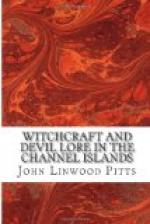as a witch at Rouen, May 30th, 1431; in 1484 Pope
Innocent VIII. issued a bull against witchcraft, causing
persecutions to break out in all parts of Christendom;
during three months of the year 1515, about five
hundred witches were burnt at Geneva; in 1524 many
persons were burnt for the same crime in the Diocese
of Como; about the year 1520 a great number suffered
in France, and one sorcercer confessed to having
1,200 associates; from 1580 to 1595—a
period of fifteen years—about nine hundred
witches were burnt in Lorraine; between 1627 and
1629, no fewer than one hundred and fifty-seven
persons, old and young, and of all ranks, were
burnt at Wurtzburg, in Bavaria; in 1634 a clerk
named Urbain Grandier, who was parish priest
at Loudon, was burnt on a charge of having bewitched
a whole convent of Ursuline nuns; in 1654 twenty poor
women were put to death as witches in Brittany; in
1648-9 serious disturbances on account of witchcraft
took place in Massachusetts; and in 1683 dreadful
persecutions raged in Pennsylvania from the same
cause; in 1692, at Salem, in New England, nineteen
persons were hanged by the Puritans for witchcraft,
and eight more were condemned, while fifty others
confessed themselves to be witches, and were
pardoned; in 1657 the witch-judge Nicholas Remy boasted
of having burnt nine hundred persons in fifteen
years; in one German principality alone, at least
two hundred and forty-two persons were burnt
between 1646 and 1651, including many children
from one to six years of age; in 1749 Maria Renata
was burnt at Wurtzburg for witchcraft; on January
17th, 1775, nine old women were burnt at Kalish, in
Poland, on a charge of having bewitched and rendered
unfruitful the lands belonging to the palatinate;
at Landshut, in Bavaria, in 1756, a young girl
of thirteen years was convicted of impure intercourse
with the Devil and put to death. There were
also executions for sorcery at Seville, in Spain,
in 1781, and at Glarus, in Switzerland, in 1783;
while even as late as December 15th, 1802, five women
were condemned to death for sorcery at Patna, in the
Bengal Presidency, by the Brahmins, and were all
executed.
IN ENGLAND the record of Witchcraft is also a melancholy chapter. A statute was enacted declaring all witchcraft and sorcery to be felony without benefit of clergy, 33 Henry VIII. 1541; and again 5 Elizabeth, 1562, and 1 James I. 1603. The 73rd Canon of the Church, 1603, prohibits the Clergy from casting out devils. Barrington estimates the judicial murders for witchcraft in England, during two hundred years, at 30,000; Matthew Hopkins, the “witch-finder,” caused the judicial murder of about one hundred persons in Essex, Norfolk, and Suffolk, 1645-7; Sir Matthew Hale burnt two persons for witchcraft in 1664; about 1676 seventeen or eighteen persons were burnt as witches at St. Osyths, in Essex; in 1705 two pretended witches were executed at Northampton, and five others seven years afterwards; in 1716, a Mrs. Hicks, and her daughter, a little




